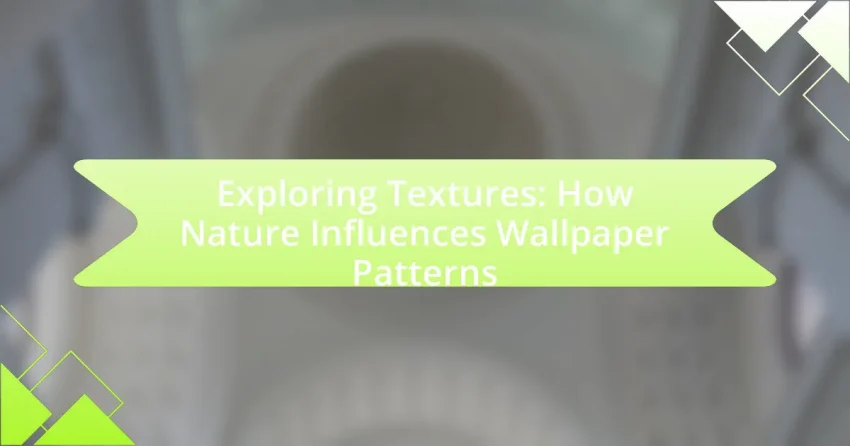The article “Exploring Textures: How Nature Influences Wallpaper Patterns” examines the various natural textures that inspire wallpaper designs, including wood grain, stone surfaces, leaf veins, and animal fur. It discusses how these textures not only enhance aesthetic appeal but also promote well-being by creating a calming atmosphere in interior spaces. The article further explores the cultural significance of natural patterns in wallpaper, the impact of different environments on design choices, and the techniques used in wallpaper production to replicate these textures. Additionally, it highlights the importance of sustainable practices and emerging technologies in the wallpaper industry, providing insights into how consumers can select wallpapers that effectively reflect natural textures.

What are the key textures found in nature that influence wallpaper patterns?
Key textures found in nature that influence wallpaper patterns include wood grain, stone surfaces, leaf veins, and animal fur. Wood grain provides a warm, organic feel, often used in rustic or natural-themed designs. Stone surfaces, such as marble or granite, offer a sense of elegance and durability, frequently appearing in contemporary styles. Leaf veins create intricate patterns that evoke a sense of freshness and vitality, commonly utilized in botanical prints. Animal fur textures, like those of leopard or zebra, introduce a bold and exotic element, appealing to adventurous design choices. These natural textures are often replicated in wallpaper to bring the essence of the outdoors into interior spaces, enhancing aesthetic appeal and creating a connection to nature.
How do natural textures inspire design choices in wallpaper?
Natural textures inspire design choices in wallpaper by providing organic patterns and color palettes that evoke a sense of tranquility and connection to the environment. Designers often draw from elements such as wood grain, stone surfaces, and foliage to create visually appealing and tactile experiences. For instance, the use of earthy tones and irregular patterns mimics the randomness found in nature, which can enhance the aesthetic appeal of interior spaces. Research indicates that incorporating natural elements in design can improve well-being and reduce stress, as seen in studies published in the Journal of Environmental Psychology, which highlight the positive effects of biophilic design on human emotions and behavior.
What specific elements of nature are commonly reflected in wallpaper textures?
Common elements of nature reflected in wallpaper textures include leaves, flowers, wood grains, stones, and water patterns. These natural motifs are often used to evoke a sense of tranquility and connection to the outdoors. For instance, floral designs can mimic the intricate patterns found in gardens, while wood grain textures can replicate the appearance of natural timber, providing warmth and organic appeal. The use of these elements is supported by design trends that emphasize biophilic design, which aims to enhance well-being by incorporating natural elements into interior spaces.
How do different environments contribute to unique wallpaper patterns?
Different environments contribute to unique wallpaper patterns by influencing the colors, textures, and motifs that designers draw from nature. For instance, coastal environments often inspire patterns featuring marine life and sandy textures, while forested areas may lead to designs that incorporate leafy patterns and earthy tones. Research indicates that the visual elements found in specific ecosystems, such as the vibrant colors of tropical flora or the muted hues of arid landscapes, directly inform the aesthetic choices in wallpaper design. This connection between environment and design is evident in collections that reflect local biodiversity, showcasing how geographical features and climate conditions shape artistic expression in wallpaper patterns.
Why is it important to consider nature in wallpaper design?
Considering nature in wallpaper design is important because it enhances aesthetic appeal and promotes well-being. Natural elements in designs can create a calming atmosphere, which has been shown to reduce stress and improve mood. Research indicates that environments incorporating natural imagery can lead to increased feelings of relaxation and satisfaction. For example, a study published in the Journal of Environmental Psychology found that exposure to nature-inspired designs can significantly enhance emotional well-being. Thus, integrating nature into wallpaper design not only beautifies spaces but also contributes positively to mental health.
What psychological effects do natural textures have on interior spaces?
Natural textures in interior spaces evoke feelings of calmness, connection to nature, and overall well-being. Research indicates that incorporating elements like wood, stone, and organic fabrics can reduce stress and enhance mood by creating a sense of tranquility. A study published in the Journal of Environmental Psychology found that environments featuring natural materials significantly improved occupants’ emotional states and cognitive performance compared to those with synthetic textures. This connection to nature, often referred to as biophilia, suggests that natural textures can foster a more positive psychological atmosphere, promoting relaxation and reducing anxiety.
How does incorporating nature into wallpaper design enhance aesthetic appeal?
Incorporating nature into wallpaper design enhances aesthetic appeal by creating a sense of tranquility and connection to the outdoors. Natural elements, such as floral patterns, landscapes, and organic textures, evoke feelings of serenity and well-being, which are supported by studies indicating that exposure to nature can reduce stress and improve mood. For instance, research published in the Journal of Environmental Psychology shows that environments featuring natural imagery can lead to increased feelings of relaxation and satisfaction. Thus, the integration of nature in wallpaper not only beautifies spaces but also contributes positively to the psychological state of individuals within those environments.

How do various cultures interpret natural textures in wallpaper design?
Various cultures interpret natural textures in wallpaper design through unique aesthetic values and symbolic meanings. For instance, Japanese design often emphasizes simplicity and harmony with nature, utilizing textures that mimic natural elements like bamboo or water ripples, reflecting the cultural principle of wabi-sabi, which appreciates imperfection and transience. In contrast, Scandinavian design frequently incorporates textures inspired by the rugged landscapes and forests, using earthy tones and organic patterns to evoke a sense of coziness and connection to the outdoors. Additionally, Indigenous cultures may use textures that represent their specific environments, such as the intricate patterns of leaves or animal fur, to convey cultural narratives and spiritual connections to nature. These interpretations are rooted in each culture’s historical context, environmental interactions, and philosophical beliefs, demonstrating how wallpaper design serves as a canvas for cultural expression through natural textures.
What cultural significance do natural patterns hold in wallpaper design?
Natural patterns in wallpaper design hold significant cultural value as they often reflect the relationship between humans and nature, symbolizing harmony, growth, and renewal. Historically, various cultures have utilized motifs inspired by flora and fauna to convey their beliefs and values; for instance, Japanese wallpaper often features cherry blossoms, representing the transient beauty of life, while European designs may incorporate intricate vine patterns that signify prosperity and fertility. These patterns not only enhance aesthetic appeal but also serve as a means of storytelling, connecting individuals to their cultural heritage and the natural world.
How do traditional designs differ from contemporary interpretations of nature?
Traditional designs often emphasize intricate patterns and motifs derived from nature, reflecting cultural heritage and historical contexts, while contemporary interpretations prioritize minimalism and abstraction, focusing on simplified forms and innovative materials. Traditional designs, such as those found in historical wallpaper patterns, often feature detailed representations of flora and fauna, showcasing craftsmanship and a connection to specific cultural narratives. In contrast, contemporary designs may utilize digital technology to create stylized or abstract representations of natural elements, emphasizing color and texture over realism. This shift reflects broader trends in design that favor versatility and adaptability in modern interiors, as evidenced by the rise of eco-friendly materials and sustainable practices in contemporary wallpaper production.
What role does regional flora and fauna play in cultural wallpaper patterns?
Regional flora and fauna significantly influence cultural wallpaper patterns by reflecting the natural environment and biodiversity of a specific area. These patterns often incorporate local plants and animals, serving as a visual representation of the region’s identity and heritage. For instance, traditional Japanese wallpaper frequently features cherry blossoms and cranes, symbolizing beauty and longevity, while tropical wallpaper designs may showcase vibrant parrots and palm leaves, highlighting the lush ecosystems of those areas. This connection between nature and design not only enhances aesthetic appeal but also fosters a sense of place and cultural pride, as seen in the use of indigenous species in various global wallpaper styles.
How can understanding cultural interpretations enhance wallpaper design?
Understanding cultural interpretations can enhance wallpaper design by allowing designers to create patterns that resonate with specific cultural values and aesthetics. For instance, incorporating motifs that reflect traditional symbols or colors significant to a culture can evoke emotional connections and enhance the overall appeal of the wallpaper. Research indicates that culturally relevant designs can increase consumer engagement and satisfaction, as seen in studies where products aligned with cultural identities showed higher purchase intent among target demographics. By integrating these cultural elements, designers can produce wallpaper that not only beautifies spaces but also tells a story, making it more meaningful and desirable to consumers.
What are the benefits of blending cultural elements with natural textures?
Blending cultural elements with natural textures enhances aesthetic appeal and fosters a deeper emotional connection to the environment. This combination creates visually rich designs that reflect diverse cultural narratives while simultaneously invoking the organic beauty of nature. For instance, incorporating traditional patterns from various cultures into wallpaper designs can evoke a sense of place and history, making spaces feel more personalized and inviting. Additionally, studies have shown that environments featuring natural textures can reduce stress and promote well-being, while cultural elements can enhance the sense of identity and belonging. Thus, the integration of these aspects not only beautifies spaces but also contributes positively to psychological health and cultural appreciation.
How can designers create a dialogue between nature and culture in wallpaper?
Designers can create a dialogue between nature and culture in wallpaper by integrating organic motifs and cultural symbols into their designs. This approach allows for the representation of natural elements, such as flora and fauna, alongside traditional patterns or cultural icons, fostering a visual conversation that reflects both the environment and cultural heritage. For instance, the use of botanical illustrations inspired by local ecosystems can be combined with geometric patterns that represent cultural artistry, creating a cohesive design that honors both aspects. This method not only enhances aesthetic appeal but also promotes awareness of environmental themes and cultural narratives, as seen in collections that draw inspiration from indigenous art forms and local landscapes.

What techniques are used to replicate natural textures in wallpaper production?
Techniques used to replicate natural textures in wallpaper production include digital printing, embossing, and the use of textured substrates. Digital printing allows for high-resolution images that mimic natural elements like wood grain or stone patterns. Embossing creates a three-dimensional effect, enhancing the tactile quality of the wallpaper to resemble surfaces found in nature. Textured substrates, such as non-woven or vinyl materials, can also be designed to imitate the feel and appearance of natural textures, providing a realistic look and feel. These methods collectively enable manufacturers to create wallpapers that closely resemble various natural textures, appealing to consumer preferences for organic aesthetics.
How do printing technologies capture the essence of natural textures?
Printing technologies capture the essence of natural textures by utilizing advanced techniques such as digital printing, screen printing, and embossing to replicate the intricate details and tactile qualities found in nature. Digital printing allows for high-resolution images that can mimic the fine nuances of surfaces like wood grain or stone, while screen printing can layer inks to create depth and dimension, enhancing the visual representation of textures. Embossing adds a physical relief that simulates the feel of natural materials, making the printed surface more lifelike. These methods enable designers to create wallpaper patterns that reflect the organic beauty of nature, effectively bridging the gap between artificial and natural aesthetics.
What are the most common printing methods used for textured wallpapers?
The most common printing methods used for textured wallpapers are digital printing, screen printing, and rotary printing. Digital printing allows for high-resolution images and intricate designs, making it suitable for custom textures. Screen printing is a traditional method that uses stencils to apply ink, ideal for bold patterns and textures. Rotary printing, often used for mass production, employs a cylindrical screen to transfer designs onto wallpaper, enabling efficient and consistent texture application. These methods are widely utilized in the wallpaper industry due to their effectiveness in producing detailed and varied textured designs.
How do material choices affect the replication of natural textures?
Material choices significantly impact the replication of natural textures by determining the fidelity and realism of the final product. For instance, materials like vinyl and non-woven fabrics can mimic the appearance of wood or stone through advanced printing techniques, allowing for intricate details and depth that resemble natural surfaces. Research indicates that the texture and finish of the material, such as matte versus glossy, can further enhance or diminish the authenticity of the replication, as seen in studies where textured surfaces were compared to smooth ones, revealing that textured materials provide a more lifelike representation.
What innovations are shaping the future of textured wallpaper design?
Innovations shaping the future of textured wallpaper design include advancements in digital printing technology, eco-friendly materials, and interactive designs. Digital printing allows for intricate patterns and textures to be reproduced with high precision, enabling designers to create wallpapers that mimic natural elements like wood and stone. Eco-friendly materials, such as recycled fibers and non-toxic inks, are increasingly being used to meet consumer demand for sustainable products. Additionally, interactive designs that incorporate augmented reality (AR) enable users to visualize how textures will look in their space before installation, enhancing the overall design experience. These innovations reflect a growing trend towards personalization and sustainability in interior design.
How are sustainable practices influencing wallpaper production?
Sustainable practices are significantly influencing wallpaper production by promoting the use of eco-friendly materials and manufacturing processes. Manufacturers are increasingly opting for natural fibers, such as organic cotton and hemp, as well as water-based inks and adhesives, which reduce environmental impact. For instance, a report from the Sustainable Furnishings Council indicates that the use of recycled materials in wallpaper production has increased by 30% over the past five years, reflecting a shift towards sustainability. Additionally, companies are adopting practices that minimize waste and energy consumption, aligning with global sustainability goals. This transformation not only meets consumer demand for environmentally responsible products but also contributes to the overall reduction of the industry’s carbon footprint.
What emerging technologies are enhancing the realism of natural textures?
Emerging technologies enhancing the realism of natural textures include advanced 3D scanning, photogrammetry, and procedural generation. 3D scanning captures the intricate details of natural surfaces, allowing for highly accurate digital representations. Photogrammetry utilizes multiple photographs to create 3D models, preserving texture fidelity and depth. Procedural generation algorithms create complex textures based on mathematical models, enabling the simulation of natural variations. These technologies collectively improve the authenticity of textures in applications such as wallpaper design, where realistic representations are crucial for aesthetic appeal.
What tips can help consumers choose wallpaper that reflects natural textures effectively?
To choose wallpaper that effectively reflects natural textures, consumers should consider options that mimic organic materials like wood, stone, or fabric. Selecting wallpapers with realistic patterns and tactile finishes, such as embossed or textured surfaces, enhances the natural feel. Additionally, opting for colors found in nature, such as earthy tones and soft pastels, can further reinforce the connection to the outdoors. Research indicates that incorporating natural elements in interior design can improve well-being and create a calming atmosphere, making these choices not only aesthetic but also beneficial for mental health.
